Chainsaw maintenance

A chainsaw is what you would call a versatile tool: useful for routine and emergency tree surgery in the garden and countryside, for managing woodland vegetation, for DIY and free-time projects, and even for jobs around the home.
Whether you use one as a hobby or professionally, every type of chainsaw should be looked after with careful maintenance. That way, you will not only have a chainsaw that is always efficient and gives you many years of valuable service, but you will also expend less effort when using it and, above all, stay safer when working.
Today we find out what maintaining a chainsaw involves. We start with its typical components, the guide bar and chain, which should be checked before and/or after every cut.
Chain and guide bar maintenance
Before you start servicing your chainsaw, protect your hands with chain-resistant gloves, especially when handling the chain. Make sure that the engine is switched off, cooled down and that the moving parts have come to a standstill. If it is a petrol engine chainsaw, check that the muffler is also cool and detach the boot cap from the spark plug. If you have an electric chainsaw, such as the GS 200 E, unplug the power lead from the mains socket.
The chain is, literally and figuratively, the cutting edge of the chainsaw. Given the same power supply, power rating etc., the machine’s performance depends on the efficiency of the chain itself. Here are some steps you can follow to ensure proper maintenance of the chainsaw cutting chain, whatever your machine's power supply:
-
Check whether it is damaged, worn and that the teeth still have sharp edges.
-
Degrease the chain and guide bar with a specific detergent.
-
If necessary, sharpen the chain teeth with a round file. Follow the chainsaw manufacturer’s instructions to determine the correct diameter of round file and the best sharpening angle. After every 3-4 passes with the file, check the tooth depth limiters and, if necessary, go over them with a flat file.
-
Adjust the chain tension: when suitably tensioned it will stay tight around the guide bar, but sufficiently slack so that when you pull it upwards, it rises enough to expose 3-4 drive links.
To calibrate the chain tension on many chainsaws, you simply tighten the chain tensioner on the side (or front) of the machine with a screwdriver. This applies to several Oleo-Mac models, for example on the medium power GS 451, the GST 250 pruning chainsaw and the GS 651 professional chainsaw. Or you simply turn a knob without the need for a screwdriver, as on the GS 200 E electric chainsaw.
Just like the chain, the chainsaw guide bar needs maintenance too:
-
Keep the chain oil pump and circuit clean: want to know how? Read our article on how a chainsaw oil pump works.
-
Turn the guide bar over periodically (approximately every 8 hours of operation) so that both sides wear evenly.
-
File the burrs that form on the guide bar grooves and, if they are worn asymmetrically, also file down the groove walls.
-
At the same time, check whether the sprocket is worn or damaged and, if so, take it to be replaced: if it is an Oleo-Mac chainsaw, contact your nearest assistance centre.
When necessary, the chain and guide bar should be replaced: we generally recommend changing your guide bar at every fourth chain replacement.
Whatever the chainsaw’s power supply—electric, battery or petrol—the guide bar/chain unit needs adequate lubrication so that the chain runs smoothly, with minimal friction. So, check your chain oil reservoir often and top up when needed.
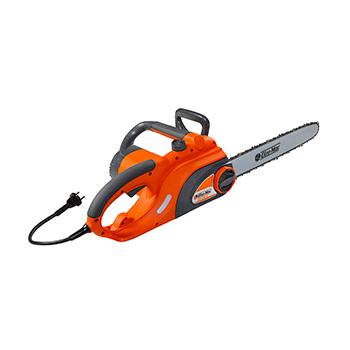
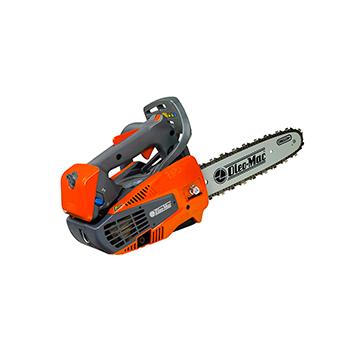
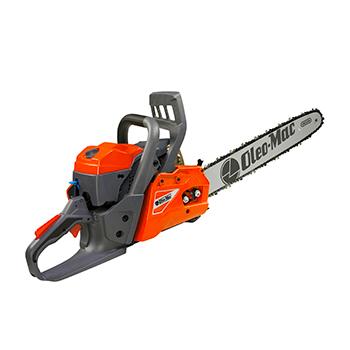
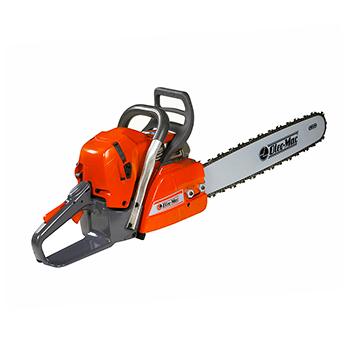
Chainsaws and routine maintenance
Routine maintenance of your chainsaw should be performed every time you finish sawing and/or before starting work, or as a minimum at regular intervals, depending on how much you use the chainsaw and how intensively you use it. These guidelines apply to all types of machine, regardless of their power supply:
-
Inspect the chainsaw: check that the casing is not damaged and check the tightness of visible screws and nuts.
-
Check the operation of the various switches and controls and, in the case of petrol engine chainsaws, also check the condition of the starter rope.
-
After cutting, clean away any wood chips and shavings, chain oil and dirt in general. Use a dry cloth, and a brush for the most stubborn debris. Don’t use harsh or abrasive chemicals.
-
In particular, unblock the air intakes of the engine crankcase using a brush, or compressed air if possible.
-
Before starting work, check that the chain brake works perfectly with both manual and automatic engagement. Not working? Stop using the chainsaw and contact an assistance centre.
If you have an electric chainsaw, make sure that the power lead is intact: if it is damaged or shows signs of wear, we recommend that you have it replaced by an assistance centre.
For routine maintenance of your petrol engine chainsaw, first check that the fuel tank and engine oil reservoir are intact, then clean the:
-
Air filter: wipe with degreaser and water, then dry by blowing compressed air from the inside to the outside of the filter from a distance. Replace it if heavily clogged or damaged.
-
Fuel filter: check its condition. It should be changed if it is very dirty.
-
Engine cylinder fins: clean using a brush or compressed air.
-
Spark plug: after cleaning it, check and, if necessary, adjust the distance between the electrodes. If necessary, replace it with a new spark plug of the type indicated in your chainsaw’s user manual.
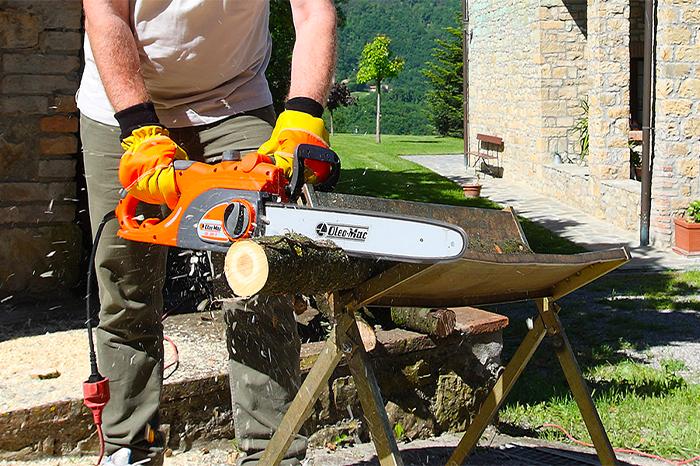
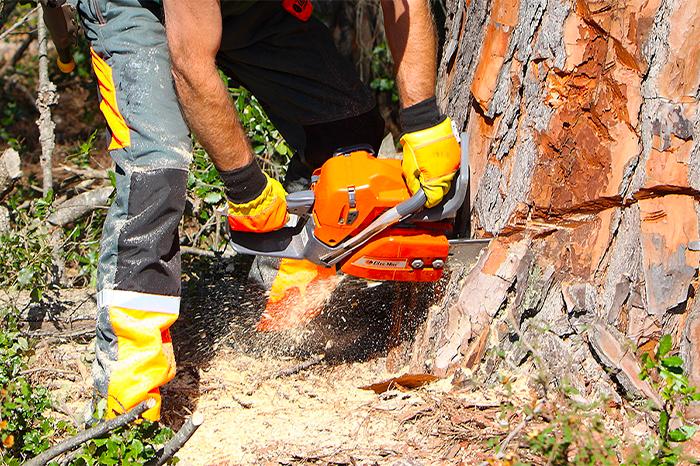
End-of-season chainsaw maintenance
Annually or every 2 years, at the end of the season we recommend that you have a technician perform a general check-up on your chainsaw. If it is an Oleo-Mac model, get in touch with one of our assistance centres. If the chainsaw is electric, take this opportunity to have the motor brushes inspected and, if necessary, replaced.
Before stowing your chainsaw away for the winter, or if you don’t plan on using it for a while:
-
Thoroughly clean the chainsaw, following the routine maintenance steps above.
-
Empty the chain oil pump reservoir and circuit.
-
Clean the guide bar and chain, then lubricate them with protective oil.
-
If it is a petrol chainsaw, empty and clean the fuel tank and engine oil reservoir. Also drain the carburettor by keeping the chainsaw running until it stops by itself.
-
Follow all the routine maintenance steps, especially in the case of petrol engine chainsaws, and check and clean the air filter, fuel filter, engine cylinder fins and spark plug.
After the end-of-season service is completed, protect the guide bar with the bar cover and store the machine in a dry, sheltered place, away from heat sources and ideally off the floor. If it is electric, the power lead should remain unplugged from the socket at all times.
Earlier we mentioned that the chainsaw is a versatile tool: depending on the model it enables you to do a series of jobs. We talk more about them in our articles: when to cut firewood, how to prune a tree, our guide to limbing, sectioning and bucking trees and (particularly if you use a pruning chainsaw) how to make sculptures with a chainsaw.



